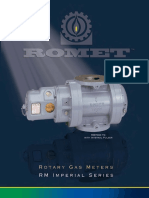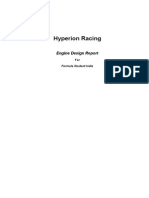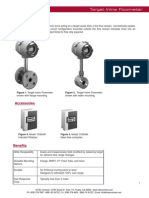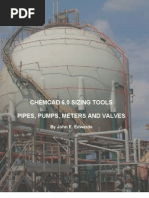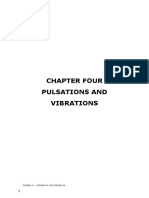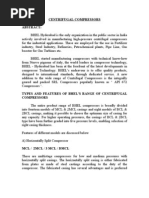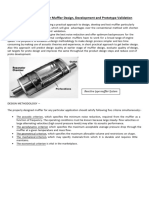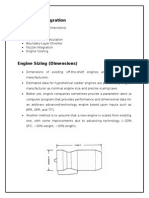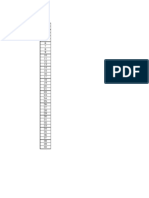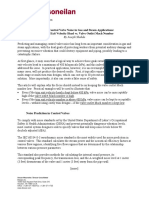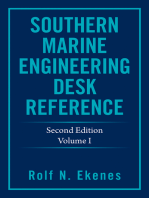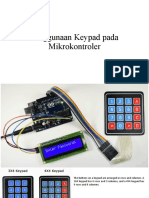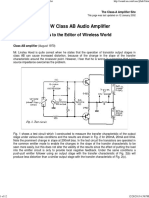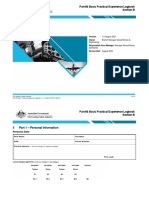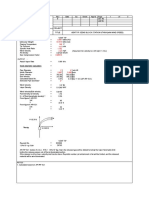Intake Design v1 8
Intake Design v1 8
Uploaded by
freak_brooklinCopyright:
Available Formats
Intake Design v1 8
Intake Design v1 8
Uploaded by
freak_brooklinOriginal Description:
Copyright
Available Formats
Share this document
Did you find this document useful?
Is this content inappropriate?
Copyright:
Available Formats
Intake Design v1 8
Intake Design v1 8
Uploaded by
freak_brooklinCopyright:
Available Formats
Quick Intake Design Calculator v1.
8
Independent Throttle Body Tuning
By Stefan Vince
For use with ITB induction or plenum type induction with very large plenum sizes ( > 1 x engine capacity).
Base Engine Data
Bore: Stroke: Rod length: Port C/L length: Peak HP RPM: Intake cam duration (0.050"): Intake air temperature:
Calculation Results
103.25 90.932 155.52 0 6900 280 37 98.6
mm mm mm mm
deg deg C deg F
Suggested Runner Diameters. Minimum: 45.3 mm 1.78 in Best: 46.2 mm 1.82 in Maximum: 47.1 mm 1.85 in
Suggested Runner Areas. Minimum: 1610.9 mm^2 2.497 in^2 Best: 1674.4 mm^2 2.595 in^2 Maximum: 1743.3 mm^2 2.702 in^2
Suggested Runner Mach Numbers at Peak HP RPM. Minimum: 0.502 At Peak Piston Speed - Mach number should be 0.500 or less for the runner diameter being used or choke in Best: 0.483 the port will occur. Maximum: 0.463 Suggested Runner Entry Diameter/Area For Tapered Runners. Best: 61.4 mm Best: 2961.9 mm^2 2.42 in 4.591 in^2 Suggested Runner CFM at 28"H2O For Peak HP RPM. 246.0 (At 100% VE) 270.6 (At 110% VE) 295.2 (At 120% VE) 319.8 (At 130% VE) Suggested Runner Lengths. 1st Harmonic: 895 mm 35.25 in 2nd Harmonic: 501 mm 19.71 in 3rd Harmonic: 358 mm 14.10 in 4th Harmonic: 287 mm 11.28 in 5th Harmonic: 239 mm 9.40 in
(Total: (Total: (Total: (Total: (Total: (Total: (Total: (Total: (Total: (Total:
895 35.25 501 19.71 358 14.10 287 11.28 239 9.40
mm) in) mm) in) mm) in) mm) in) mm) in)
Suggested Peak Torque RPM Using 2nd Harmonic. 5245 TO 5745
Notes. Peak torque rpm is based on 2nd Harmonic intake length only and will be affected by other factors than the intake length alone and so actual values could be lower or higher than calculated values. Intake length calculations are based on NACA-TN-935 by Boden et al and the work of Prof. G. P. Blair. Diameters based on mean runner speed of 73-79m/sec (240-260ft/sec). Suggested runner CFM from David Vizard's "How to Build & Modify Cheverolet Small -block V-8 Cylinder Heads".
Quick Intake Design Calculator v1.8
Resonance Tuning
By Stefan Vince
For use with OEM style plenum manifolds for EFI and Turbo.
Inputs
Results
Intake air temp: Runner average dia D1: Total runner length L1: No. of runners:
40 37.2 245 4
TRUE
deg C mm mm
Natural frequency of total intake system: Natural frequency of runner only: Runner tuned rpm (2nd harmonic): Runner tuned rpm (3rd harmonic): Runner tuned rpm (4th harmonic): Total system upper tuned rpm: Total system lower tuned rpm:
57.7 347.0
Hz Hz
Runner bellmouth?
9713 6515 4877 6720 3260
to to to to to
10113 6915 5277 7120 3660
Plenum volume V: Zip tube dia D2: Zip tube length L2: Runner Spacing
Less than port spacing
2
1.8 63 1000
FALSE
Litres mm mm
Zip tube bellmouth?
Port spacing or greater
Notes. Tuned RPM values are derived from SAE 820407 by Ohata et al, SAE 2006-01-3653 and SAE 2007-01-1399 by Brennan et al. Calculating the natural frequency of a total manifold system is not entirely accurate. Higher accuracy is obtained with simple plenum designs. The more complex a manifold system is the more chance it's actual natural frequency will be higher or lower than the calculated values. The only accurate way of finding the natural frequency of a total manifold system is by performing a frequency sweep using CFD or by using the actual manifold and using acoustical methods (loudspeaker and microphone) to determine at what frequency it will go into resonance. Tuning values for the total manifold are dependent on the runner spacing and internal geometry of the plenum. Close runner spacings will dampen or cancel frequencies excited by single cylinder frequency and be excited by multiple cylinder frequencies and their harmonics. Large runner spacings will dampen or cancel some multiple cylinder frequencies whilst allowing excitation by single cylinder frequencies. The user is referred to the above SAE papers for more details. *Use the I.T.B Tuning worksheet to determine initial runner lengths and diameters*
Quick Intake Design Calculator v1.8
Throttle Body Sizing.
By Stefan Vince Inputs Results
Maximum RPM: Engine Displacement: Number of Cylinders: Volumetric efficiency: Intake air temp: Intake air pressure: Compressor or intercooler flowrate: Throttle CD value: Pressure drop:
6500 1998 122 4 100 104 40.0 21.5 1.48 40 0.836 0.5
cc's ci's
Intake air density: Intake air velocity: Average CFM demand: Peak CFM demand:
0.173 163.4 230.6 230.6 58 2.3 0.140
lb/ft^3 ft/sec CFM CFM mm inches
% Throttle body size: Degrees F Degrees C Psi Bar lb/min Throttle body mach no:
Notes. This spreadsheet uses simplified calculations and that greater accuracy would be obtained by using formulas for compressible flow through orifices and accurately determined CD maps.
Psi
Coefficient of Discharge Calculator.
Area Method Measurement Method
Throttle body size: Throttle shaft dia:
57 2.24 6 0.24
mm inches mm inches
Throttle body size: Flow bench CFM@20.4" H2O:
65 2.56 509
mm inches CFM
CD: 0.836
CD:
0.788
Quick Intake Design Calculator v1.8
Bellmouth Design.
By Stefan Vince
Inputs
Runner diameter:
37.2
mm
If the runner is non-circular its hydraulic diameter needs to be calculated and used to determine the major and minor axis of the bellmouth.
Runner area: 0 Runner circumference: 0 Hydraulic diameter: #DIV/0!
Runner diameter
1
mm^2 mm mm
Notes. This worksheet is used to design bellmouths for runner entries. They are both based on ASME nozzle/bellmouth design principles and both have Cd values of over 0.95. Type A works well up to ~Mach 0.65 and is quite compact. Type B is more efficient and works up to ~Mach 0.95 but is limited to larger runner spacings. Bellmouth profiles are elliptical and can be easily drawn using CAD or traditional drafting methods. Always make a template to check the internal profile.
Hydraulic diameter
Results Type A
Type B
Major axis: Minor axis: Radius R: Inlet diameter: Area ratio: Minimum centres:
37.2 18.6 7.4 74.4 4.0 92.3
mm mm mm mm :1 mm
Major axis: Minor axis: Radius R: Inlet diameter: Area ratio: Minimum centres:
37.2 24.8 7.4 86.8 5.4 104.7
mm mm mm mm :1 mm
You might also like
- 7S50MC-C8-TII TCA66-21 127.0 RPM 11060 KWDocument16 pages7S50MC-C8-TII TCA66-21 127.0 RPM 11060 KWАлександр ТихомировNo ratings yet
- 7S50MC-C7-TI TCA66-21 127.0 RPM 11060 KWDocument16 pages7S50MC-C7-TI TCA66-21 127.0 RPM 11060 KWАлександр ТихомировNo ratings yet
- Romet Rotary Gas MeterDocument8 pagesRomet Rotary Gas MeterAlvaro Jhoel Quinteros R100% (1)
- Performance Exhaust Systems: How to Design, Fabricate, and Install: How to Design, Fabricate, and InstallFrom EverandPerformance Exhaust Systems: How to Design, Fabricate, and Install: How to Design, Fabricate, and InstallRating: 4 out of 5 stars4/5 (8)
- Addie Vs AssureDocument10 pagesAddie Vs AssureCML78100% (1)
- Reliability Is Job 1 ™: 2014© Geo Pressure Systems International Inc., Calgary, Alberta, CanadaDocument39 pagesReliability Is Job 1 ™: 2014© Geo Pressure Systems International Inc., Calgary, Alberta, CanadaLuisNo ratings yet
- Intake Design v1 8Document4 pagesIntake Design v1 8salahvacNo ratings yet
- Quick Intake Design Calculator v1.8: Independent Throttle Body TuningDocument6 pagesQuick Intake Design Calculator v1.8: Independent Throttle Body TuningRajendra Shah100% (1)
- Engine Design Report For Formula Student CompetitonDocument28 pagesEngine Design Report For Formula Student CompetitonNishant NagleNo ratings yet
- Product Design of MufflerDocument16 pagesProduct Design of MufflernaniNo ratings yet
- B3 16M175Document2 pagesB3 16M175ecovarrubias1No ratings yet
- PV 1024Document1 pagePV 1024ritu_s_agarwalNo ratings yet
- Capacity Curing Management of Continuous Centrifugal MachinesDocument42 pagesCapacity Curing Management of Continuous Centrifugal MachinesArun GuptaNo ratings yet
- Steam Line Sizing CalculationsDocument11 pagesSteam Line Sizing Calculationssantosh_raju0% (1)
- RPM Outlets Formula PageDocument3 pagesRPM Outlets Formula Pagerudey18No ratings yet
- Connecting Rod Vs Stroke RatioDocument11 pagesConnecting Rod Vs Stroke RatioJameel Khan0% (1)
- Principle of Operation: Target Inline FlowmeterDocument7 pagesPrinciple of Operation: Target Inline Flowmeterابزار دقیقNo ratings yet
- Garrett Turbo System OptimizationDocument11 pagesGarrett Turbo System OptimizationlaaliautoNo ratings yet
- Exhaust and Muffler Design of A Formula SAE CarDocument14 pagesExhaust and Muffler Design of A Formula SAE CarMohit Mundra67% (3)
- Design: Following Are The Basic Steps To Design An Oil Mist SystemDocument10 pagesDesign: Following Are The Basic Steps To Design An Oil Mist SystemDiyaNegiNo ratings yet
- HSN 7461-70Document11 pagesHSN 7461-70codymasterNo ratings yet
- Boost Bottle CalculatorDocument2 pagesBoost Bottle CalculatorEnrico Caveglia Curtil100% (1)
- Drilling Formulas Calculation Sheet Verson 1.3Document186 pagesDrilling Formulas Calculation Sheet Verson 1.3Sarhad Ahmed100% (1)
- Chemcad Sizing ToolsDocument48 pagesChemcad Sizing Toolsparedanil100% (1)
- Optimization of A High-Efficiency Jet Ejector by Using CFDDocument54 pagesOptimization of A High-Efficiency Jet Ejector by Using CFDagnotts09No ratings yet
- Technical Bid Dindoli r3 Part 2Document292 pagesTechnical Bid Dindoli r3 Part 2Arun GuptaNo ratings yet
- Compressors Course-Chapter 4 PDFDocument11 pagesCompressors Course-Chapter 4 PDFMohamed TallyNo ratings yet
- Transfer Pump BrochureDocument12 pagesTransfer Pump BrochureRafert RamNo ratings yet
- Designing & Validating A New Intake Manifold For A Formula SAE CarDocument5 pagesDesigning & Validating A New Intake Manifold For A Formula SAE CarHarshdeep SinghNo ratings yet
- HYD01Document6 pagesHYD01scrbdgharaviNo ratings yet
- IIT-Intake and Exhaust Manifold DesignDocument28 pagesIIT-Intake and Exhaust Manifold DesignVasudev GuptaNo ratings yet
- New Induced Jet Fan Simulation 1-7-12 New DesignDocument112 pagesNew Induced Jet Fan Simulation 1-7-12 New Designphisitlai100% (2)
- Jalloul Njah Pump Selection Project - 3 February 2016Document2 pagesJalloul Njah Pump Selection Project - 3 February 2016mauricioNo ratings yet
- Centrifugal Compressors TheoryDocument17 pagesCentrifugal Compressors Theoryvirendkumar80% (5)
- Intake and Exhaust Manifold DesignDocument28 pagesIntake and Exhaust Manifold DesignDarius Toth100% (3)
- Drilling Application: Name of Company: Well Name & Number: Date: July 12, 2013Document1 pageDrilling Application: Name of Company: Well Name & Number: Date: July 12, 2013scrbdgharaviNo ratings yet
- RS - Petronas FP1 Engine DevelopmentDocument49 pagesRS - Petronas FP1 Engine DevelopmentAiddie GhazlanNo ratings yet
- Basic Design Methodology For Muffler DesDocument9 pagesBasic Design Methodology For Muffler DesfeelcosminNo ratings yet
- 0304Document14 pages0304Hair Samayoa BrionesNo ratings yet
- Cf6 80c2 Engine.Document7 pagesCf6 80c2 Engine.Harsh Ambhore100% (1)
- Cf6 80c2 Engine.Document7 pagesCf6 80c2 Engine.Harsh AmbhoreNo ratings yet
- Ad00489m Barton 7400Document6 pagesAd00489m Barton 7400robercl51No ratings yet
- HydraulicOptimization 6617419 3 16 2015 9907957919 01 6617419 01Document26 pagesHydraulicOptimization 6617419 3 16 2015 9907957919 01 6617419 01Paola SánchezNo ratings yet
- Doosan Engine de 12 Maintenance ManualDocument10 pagesDoosan Engine de 12 Maintenance ManualJoseph100% (64)
- Improving The Process For Sizing Reciprocating CompressorsDocument7 pagesImproving The Process For Sizing Reciprocating CompressorsKong LingweiNo ratings yet
- (TP0A002) Pipeline Meter SelectionDocument3 pages(TP0A002) Pipeline Meter SelectionRoberto Carlos TeixeiraNo ratings yet
- Jet Engine IntegrationDocument8 pagesJet Engine IntegrationZeeshan100% (1)
- Tow Phase Vertical Separator Sizing 1694168084Document19 pagesTow Phase Vertical Separator Sizing 1694168084FebriansatallNo ratings yet
- Thumb Rules Xls For Chemical EngineerDocument44 pagesThumb Rules Xls For Chemical Engineershashibagewadi100% (1)
- Thumb Rules For Chemical EngineerDocument44 pagesThumb Rules For Chemical EngineerNallathambiNo ratings yet
- A15 ConceptionalDesign PDocument24 pagesA15 ConceptionalDesign PxSh0keDNo ratings yet
- VPC (Flowserve)Document5 pagesVPC (Flowserve)Wissam JarmakNo ratings yet
- Design and Size DuctworkDocument6 pagesDesign and Size Ductworkwilderness_666No ratings yet
- The Equal Friction Method of Sizing Ducts Is Easy and Straightforward To UseDocument8 pagesThe Equal Friction Method of Sizing Ducts Is Easy and Straightforward To UseRamil BelmonteNo ratings yet
- 2-Stroke-Porting TerminologyDocument5 pages2-Stroke-Porting TerminologyMithun Miranda100% (2)
- WP ValveDocument7 pagesWP ValveHamed ArianNo ratings yet
- Southern Marine Engineering Desk Reference: Second Edition Volume IFrom EverandSouthern Marine Engineering Desk Reference: Second Edition Volume INo ratings yet
- Millimeter-Wave Receiver Concepts for 77 GHz Automotive Radar in Silicon-Germanium TechnologyFrom EverandMillimeter-Wave Receiver Concepts for 77 GHz Automotive Radar in Silicon-Germanium TechnologyNo ratings yet
- AE 481 Aircraft Design - Fall 2006: Alex Murray, Manager Mark Rundle, Deputy ManagerDocument125 pagesAE 481 Aircraft Design - Fall 2006: Alex Murray, Manager Mark Rundle, Deputy ManagerPaul Lee100% (1)
- Suction Unit ConfirmationDocument15 pagesSuction Unit ConfirmationFrancis BautistaNo ratings yet
- Ctrack Online User Guide v1.0Document23 pagesCtrack Online User Guide v1.0OmerZiaNo ratings yet
- Penggunaan Keypad Pada MikrokontrolerDocument30 pagesPenggunaan Keypad Pada MikrokontrolerM NabilNo ratings yet
- Cleaner Production of Essential Oils by Steam DistillationDocument7 pagesCleaner Production of Essential Oils by Steam Distillationhagung100% (1)
- Atlas HalftoneDocument36 pagesAtlas HalftoneRomeu NataleNo ratings yet
- Transformer Worksheet 2Document4 pagesTransformer Worksheet 2abriowaisNo ratings yet
- Gernot Wersig - Museums For Far Away PublicsDocument11 pagesGernot Wersig - Museums For Far Away PublicsBernardo ArribadaNo ratings yet
- Building Construction & Graphics Autocad: by Engr. Usman AkmalDocument20 pagesBuilding Construction & Graphics Autocad: by Engr. Usman AkmalMuhammad Arslan100% (1)
- Transom Shield, Replacement KitDocument2 pagesTransom Shield, Replacement KitAlexandru DiaconuNo ratings yet
- 15-20W Class AB Audio Amplifier: Letters To The Editor of Wireless WorldDocument12 pages15-20W Class AB Audio Amplifier: Letters To The Editor of Wireless WorldDaniel ScardiniNo ratings yet
- DystopiaDocument12 pagesDystopiaAndrej ProticNo ratings yet
- Work Method Statement For Cable Excavation TrenchesDocument5 pagesWork Method Statement For Cable Excavation TrenchessamsungloverNo ratings yet
- Electronic Design and Practice - IntroductionDocument38 pagesElectronic Design and Practice - Introductionminay15No ratings yet
- Part 66 Basic Practical Experience LogbookDocument43 pagesPart 66 Basic Practical Experience LogbookAlanNo ratings yet
- Data Collection TemplateDocument10 pagesData Collection TemplateHarish Kumar JNo ratings yet
- Abstract Methods OoabapDocument21 pagesAbstract Methods Ooabapprakash bhairiNo ratings yet
- Geology Proposal Term PaperDocument19 pagesGeology Proposal Term PaperSagar Rawal100% (1)
- 025-9431 M30 Worldpatch With SelCall Instruction ManualDocument65 pages025-9431 M30 Worldpatch With SelCall Instruction ManualPedro BeltranNo ratings yet
- m935cg ManualDocument86 pagesm935cg ManualFernando GonzalesNo ratings yet
- Owner's Manual: Before Using This Product SpecificationsDocument8 pagesOwner's Manual: Before Using This Product SpecificationscriminaldNo ratings yet
- Balanceo 4 PCCDocument6 pagesBalanceo 4 PCCFreddyMejiaOrduñaNo ratings yet
- Vent Tip Sizing CalcDocument6 pagesVent Tip Sizing CalcPeddy Nesa0% (1)
- 01-Oto 1Document256 pages01-Oto 1Carla NunesNo ratings yet
- Cisco ANZ Cyber Security Fact SheetDocument2 pagesCisco ANZ Cyber Security Fact SheetCiscoANZNo ratings yet
- IT8705F/IT8705AF: Simple Low Pin Count Input / Output (Simple LPC I/O)Document186 pagesIT8705F/IT8705AF: Simple Low Pin Count Input / Output (Simple LPC I/O)Best PC BoxNo ratings yet
- KJ-66 DRW Pics SetupDocument29 pagesKJ-66 DRW Pics Setupandressosa167% (9)
- User Manual ERER 3Document16 pagesUser Manual ERER 3aleksandrNo ratings yet



